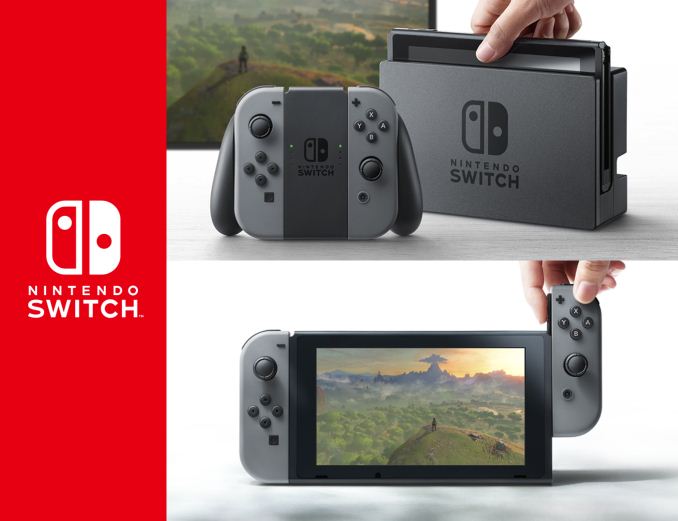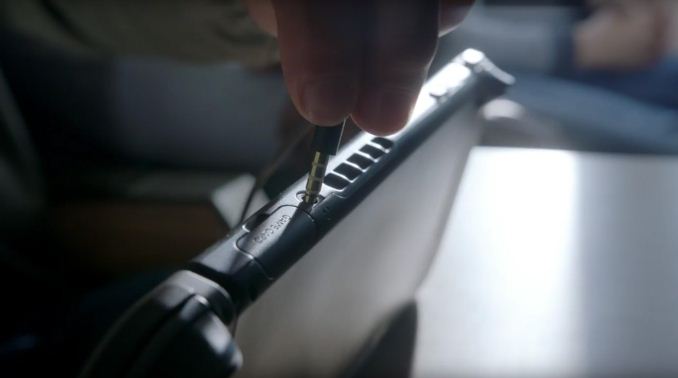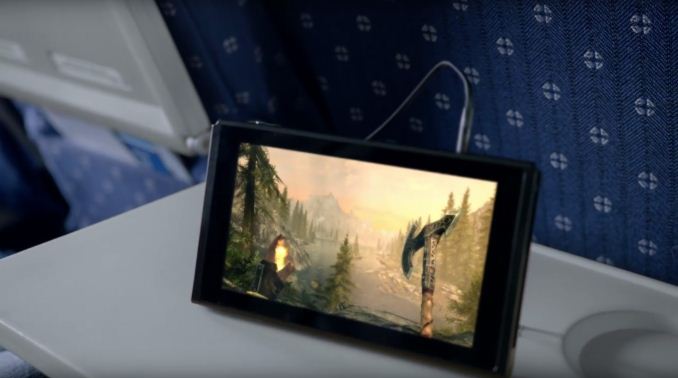Nintendo Announces Switch Portable Gaming Console - Powered by NVIDIA Tegra
by Ryan Smith on October 20, 2016 4:25 PM EST
Earlier today Nintendo took the wraps off of their next generation console, Switch. Formerly known by the codename NX, the Switch is the successor to both Nintendo’s portable DS and set top Wii console lines, utilizing a portable, tablet-like unit that can be docked to behave like a set top console. Today’s announcement, in the form of a 3 minute trailer, is meant to tease the console ahead of its full launch in March of 2017.
While I’ll skip the commentary on the console’s unusual design – dedicated gaming sites can offer better context – I wanted to dive into the hardware in the Switch. Given that this was a teaser, I was not expecting a reveal of any of the hardware specifications of the console, and indeed neither Nintendo’s teaser video nor their related press release made any mention of the underlying hardware. However shortly after the reveal went live, NVIDIA sent out an email to the press and posted a blog of their own. As it turns out, while today is still just a teaser, in some ways we’re already getting more information about the console than in any previous generation of Nintendo’s hardware.
In their blog post, NVIDIA confirmed that they would be providing the underlying SoC for the console. As this is still ultimately a teaser, NVIDIA’s own details are light, but their announcement confirms that it’s a custom version of their Tegra SoC. Curiously, no mention of the CPU core in that SoC is mentioned. However as it’s a Tegra, something ARM-based is the logical (if not only) choice. And on the GPU side, as you’d expect, they’re using a GPU based on one of NVIDIA’s existing GPU architectures, though the company isn’t specifying if it’s Pascal or Maxwell (I’d assume Pascal, but consoles are known for their long development cycles).
Otherwise, as far as specifications go that’s all we get for now. Though as NVIDIA is supplying a whole SoC there are obviously many more parts to the package that we’ll hopefully learn about in the near future. More CPU and GPU details are obviously the most interesting aspect – does the Switch SoC use Denver CPU cores? – but there’s also the matter of memory bandwidth, WiFi support, and the many other functional blocks that make up an SoC.
For NVIDIA, this is the first console hardware win for the company since the PlayStation 3, which launched in 2006. In the set top console market, AMD has since provided the GPU (and often, the CPU) for the most recent generation of consoles. Otherwise NVIDIA has never had a 3rd party portable console win, primarily because both Nintendo and Sony developed their respective SoCs internally for the 3DS and Vita.
In fact, given that Nintendo previously did much of their portable console development work internally, this is a notable shift for how the company operates. The 3DS was essentially a custom SoC combining multiple ARM11 (ARMv6) CPU cores with an OpenGL ES 1.1 generation GPU from the little-known Digital Media Professionals (DMP). So this is the first time Nintendo has contracted out their SoC needs to a third party in such a visible fashion. I’m actually a bit surprised that NVIDIA is even allowed to talk about their involvement at this point in time, given Nintendo’s historical focus on secrecy.
Though all of this also helps to underline just how big a jump in technology the Switch is from the 3DS. On the CPU side alone it’s reasonable to assume we’re looking at CPU design in the neighborhood of 4.x DMIPS/MHz, versus ARM11’s approximate 1.3 DIMPS/MHz rate, so IPC will have increased significantly, never mind an increase in frequency. Meanwhile on the GPU side, Nintendo is going from a GPU that didn’t even have a programmable GPU pipeline (i.e. shaders) to a fully modern GPU, essentially catching up on a decade of mobile GPU development in a single bound. Given that the console has to work as both the company’s portable and set top consoles, Nintendo has opted to use far more modern tech than their traditionally conservative designs.
Finally, without reading too much into a 5 paragraph announcement, there is one other interesting nugget of information in NVIDIA’s blog post that further shows just how deep the NVIDIA/Nintendo relationship is going here. Along with providing the SoC, NVIDIA also has a major stake in the development of the console’s API and middleware. While NVIDIA presumably isn’t developing the entire software stack, they make special note of the fact that they are providing a new “lightweight” API, NVN, for the console. NVIDIA is also providing middleware in the form of “a revamped physics engine, new libraries, advanced game tools and libraries” and “custom software for audio effects and rendering” which sounds a great deal like NVIDIA having brought over major parts of their GameWorks SDK, including the PhysX physics simulation libraries and VRWorks Audio library.
In any case, it will be interesting to see how this plays out over the next few months. The mobile world has changed significantly since the 3DS was launched in 2011, something that the Switch’s design makes obvious. Nintendo has gone in a very different direction than either their console rivals or the smartphone market that is always threatening to encroach on mobile consoles, and that’s reflected in both the unusual dual-mode console and the hardware inside of it.












109 Comments
View All Comments
Pissedoffyouth - Thursday, October 20, 2016 - link
uh, why?tipoo - Thursday, October 20, 2016 - link
To add to the mobility aspect?Morawka - Thursday, October 20, 2016 - link
and about $150 more to the price tag.. LTE is very expensive to integrate, else you would see it on all kinds of laptops. even the M.2 LTE cards are $250+, nevermind making sure it supports your carriers bands.Wolfpup - Friday, October 21, 2016 - link
I've seen someone else say the cell phone modem too, and I don't get it. There's less need for that than ever, since most plans have tethering, there's more free wifi around than ever, and you don't need it at all for most things anyway. If it was such a great thing, why does it always get dropped from every console that's ever had it?TheFlyingSquirrel - Thursday, October 20, 2016 - link
I have a PS4 but maybe I'm an oddball in that I've come to realize that I really dislike playing on a couch at a TV but I do love playing at a computer desk or laying down on a couch cradling some handheld in my hand. Plus I also like keeping backpack, one of those single strap bags, or a briefcase everywhere I go. This will be nice. It will nice when I use public transportation or an Uber. My last Nintendo device was the DS and the Gamecube. I'm excited. Pokemon with a properly 3D modelled world, which with their art style, won't be reaching hard for very high polys or higher res textures. It won't need some highly complex lighting and shading algorithms. It already had the latest Dragon Quest announced for it, I'm betting Kingdom Hearts 3 is announced eventually even if it's late. Even if it looks worse than the PS4, I'd still buy it for a portable device over it.It has vents and it's thicker than a phone. The device may actually be quite powerful without the throttling problems high end phones have. PS Vita is clocked ridiculously low compared to comparable phones of the time to deal with throttling. This thing is surely stronger than the Wii U in particular the CPU. They showed a lot of games so it can have some good momentum out of the gate. Zelda, Skyrim, 3D Mario, Mario Kart, Splatoon were shown. Probably won't have to wait long for a Smash Bros. Probably more Wii U ports. A rumor was out to expect Pokemon within 6 months of launch. This thing can be a solid console with the handheld and home console Nintendo teams all merging to one platform plus all the third party Japanese devs that were there for the 3DS and the Vita. I'm a believer. Sign me up. Tell me the price.
TheFlyingSquirrel - Thursday, October 20, 2016 - link
I hope it's a hit. I hope that NVN API Nvidia talked about the the Switch means something like, Nintendo Vulkan Nvidia, some extension to Vulkan for the console. If it's close enough to Vulkan maybe this will bring some cross development to Android and prop up the market there for higher quality, higher priced games.HomeworldFound - Thursday, October 20, 2016 - link
The problem is if the Switch only has Nintendo games again, that's it for Nintendo. I hope they've accounted for Microsoft's revised Xbox. If Nintendo aren't right smack in the middle of both Sony and Microsoft in order to get ports, they'll fail again and the shareholders are going to want blood.barleyguy - Thursday, October 20, 2016 - link
"The problem is if the Switch only has Nintendo games again, that's it for Nintendo."People that say things like this are, in general, very mathematically challenged.
Nintendo has a nest egg, between cash and investments, somewhere in the range of 11 Billion dollars. That's 11,000 million dollars.
Generally speaking, Nintendo makes money in their good years, and in their bad years they've lost maybe 100 million. There's actually only been a couple of those years. Even the the Wii U failing and the 3DS selling less than DS, they made money on Amiibo last year and probably on their share of Pokemon Go this year.
If they had a lot of bad years because of a failed console, and lost 100 million a year consistently, they would run out of money in 110 years. So before you say "if this console fails, that's it for Nintendo", do the math first. They could actually survive a few more generations of failed hardware and still be fine.
Morawka - Thursday, October 20, 2016 - link
no, they run out of money when their stock value plummets to pennies, which can happen overnight if the circumstances are bad enough.Look, Nintendo is run by a bunch of idiots who do no have the ability to adapt to market demands. Instead they try to re-invent them self everytime they release a console. The hit gold with the original Wii, and are chasing that high.
their first party catalog is amazing, but those releases are few and far between. Their hardware is so outside of everyone else's, that it makes 3rd party dev's re-write whole game engines just to get it to work on Nintendo. (not many do, they just refuse to release on nintendo). If porting these games takes more work than it's worth, then it simply wont come out on Nintendo.
barleyguy - Friday, October 21, 2016 - link
"no, they run out of money when their stock value plummets to pennies, which can happen overnight if the circumstances are bad enough".When a company has billions of dollars in actual bank accounts, that isn't actually possible. The value of that money isn't affected by their share price. If their stock went below their cash reserves they could do a buy back and go private.